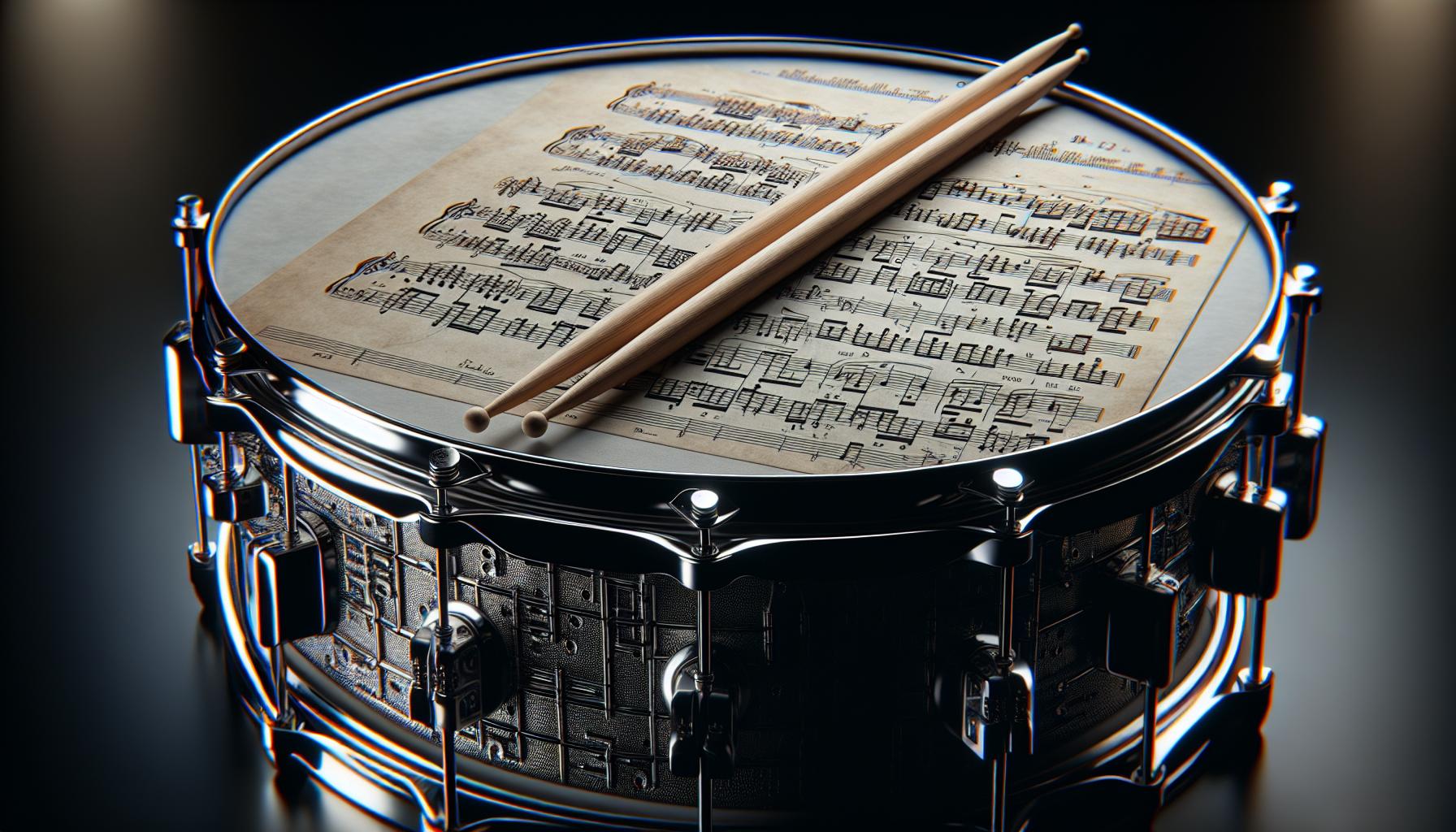As a drummer, I’ve always found snare sheet music to be an essential tool in honing my craft. It’s not just about keeping time; it’s about expressing rhythm and creativity through the snare drum. Whether you’re a beginner looking to learn basic patterns or an experienced player wanting to explore complex rhythms, snare sheet music offers a wealth of opportunities.
In this article, I’ll dive into the world of snare sheet music, sharing tips on how to read it effectively and how it can elevate your drumming skills. From classic rudiments to contemporary grooves, understanding snare sheet music can unlock new dimensions in your playing. Let’s explore how this vital resource can transform your drumming journey.
Key Takeaways
Importance of Snare Sheet Music: Essential for drummers to develop rhythm, technique, and coordination, enhancing performance across various musical genres.
Types of Snare Sheet Music: Includes rudimental patterns, warm-up exercises, grooves, etudes, and custom arrangements, catering to different skill levels and styles.
Reading Snare Sheet Music: Essential elements include understanding the staff, clefs, bar lines, note values, rests, and dynamics to interpret and play accurately.
Technique Improvement: Regular practice with snare sheet music sharpens specific drumming techniques, builds muscle memory, and enhances precision and control.
Performance Enhancement: Engaging with diverse snare patterns boosts versatility, confidence, and overall performance skills, crucial for both live and studio settings.
Resources for Snare Sheet Music: Numerous books and online platforms offer extensive collections and instructional guides to aid drummers at all levels in their practice.
Snare Sheet Music
Snare sheet music plays a vital role in a drummer’s practice and performance. It provides a structured way to learn rhythms and develop technical skills.
Importance In Percussion
Snare sheet music is essential for developing precision, timing, and coordination. It reinforces foundational techniques like rudiments, enhancing a drummer’s ability to perform complex rhythms. Many percussionists rely on snare sheet music to prepare for auditions or competitions, ensuring they meet specific stylistic and technical requirements. Mastery of snare patterns leads to improved overall drumming, enriching various musical genres.
Types Of Snare Sheet Music
Different types of snare sheet music cater to various skill levels and styles.
- Rudimental Patterns: These consist of traditional exercises, focusing on basic stroke techniques, accents, and dynamic control. Examples include single strokes, double strokes, and paradiddles.
- Warm-Up Exercises: These are designed to gradually increase technical abilities and flexibility. They often incorporate variations of rudimental patterns and dynamic exercises.
- Grooves: These patterns reflect different musical styles, such as rock, jazz, or Latin. They help drummers explore rhythmic diversity and integrate snare playing into broader musical contexts.
- Etudes: These compositions blend technical skill with musical expression, allowing drummers to apply learned techniques in a creative context.
- Custom Arrangements: Some drummers create personalized snare sheet music tailored to their specific needs, often adapting existing patterns or pieces to match their playing style.
Utilizing a variety of snare sheet music types supports continuous growth and skill enhancement for drummers at every level.
How To Read Snare Sheet Music


Reading snare sheet music requires familiarity with musical notation and rhythms. It involves understanding various symbols and their meanings to play accurately and expressively.
Understanding The Staff
The staff consists of five horizontal lines and four spaces. Each line and space represents a different pitch. For snare drum music, the following symbols are significant:
- Notes: The position of a note indicates which drum or part of the drum kit to play. For example, notes placed on the second space from the bottom typically indicate the snare drum.
- Clefs: The percussion clef, often used in snare music, signifies that the music is for non-pitched instruments. Unlike traditional treble or bass clefs, percussion clefs focus on rhythm rather than pitch.
- Bar Lines: Vertical lines divide sections of music into measures. Each measure contains a specific number of beats, which is crucial for maintaining tempo.
Rhythm And Notation
Rhythm serves as the backbone of drumming. To read rhythms in snare sheet music, observe the following elements:
- Note Values: Each note value (whole, half, quarter, eighth, and sixteenth notes) represents a specific duration. For instance, a quarter note occupies one beat, while an eighth note occupies half a beat.
- Rests: Rests signify silence for specific durations. A quarter rest lasts one beat, mirroring the duration of a quarter note.
- Time Signatures: The time signature appears at the beginning of the piece and dictates the number of beats in each measure and the type of note that receives one beat. Common time signatures include 4/4, 3/4, and 6/8.
- Dynamics: Dynamic markings indicate the volume of a passage. Common symbols include “f” for forte (loud) and “p” for piano (soft), guiding expressive play.
Recognizing these components enhances the ability to interpret and perform snare sheet music effectively. Understanding these fundamental elements fosters improved timing, precision, and overall drumming proficiency.
Benefits Of Using Snare Sheet Music


Utilizing snare sheet music brings numerous advantages to drummers, significantly impacting technique and performance. Exploring these benefits promotes greater skill development and musical expression.
Improves Technique
Snare sheet music serves as a structured roadmap for developing specific drumming techniques. Regular practice with snare sheet music allows me to focus on rudiments like flams, doubles, and paradiddles, essential for mastering the instrument. The clear notation aids in understanding dynamics, tempos, and accents, enabling me to refine my precision and control. By consistently practicing varied patterns, I enhance my coordination and build muscle memory, which is crucial for executing complex rhythms smoothly.
Enhances Performance Skills
Engaging with snare sheet music enhances my overall performance skills by encouraging versatility across genres. Different musical styles often employ unique snare techniques, and working through diverse sheet music helps me adapt to varying contexts. Mastering etudes and grooves challenges my timing, allowing me to develop better phrasing and dynamics on the snare drum. This practice directly translates to improved confidence in live performances and recordings, where rhythm and expression play vital roles. The ability to interpret and execute snare sheet music effectively empowers my artistry, helping me stand out as a drummer.
Popular Snare Sheet Music Resources


Many resources exist for those seeking snare sheet music. These resources cater to different skill levels and preferences, enabling drummers to enhance their practice and performance.
Books And Method Guides
Numerous books provide extensive snare sheet music collections, instructional insights, and methodical approaches to mastering techniques. Titles such as “Stick Control” by George Lawrence Stone focus on developing rudimental skills, while “The New Breed” by Gary Chester emphasizes independence and coordination through practical exercises. Both resources present structured methods for learning, ensuring that drummers build a solid foundation.
Online Platforms And Apps
Various online platforms and apps offer access to extensive libraries of snare sheet music. Websites like Sheet Music Plus and Musicnotes allow users to search for specific pieces, while applications such as Drumeo provide instructional videos and sheet music for various styles and levels. Additionally, platforms like Ultimate Guitar offer user-generated sheet music, creating community-driven resources for drummers. These digital tools enhance accessibility and flexibility, enabling drummers to practice anytime and anywhere.
Embracing Snare Sheet
Embracing snare sheet music has been a game changer in my drumming journey. It’s not just about hitting the right notes; it’s about unlocking creativity and refining technique. The structured approach that snare sheet music offers has helped me develop precision and coordination, essential for any drummer.
By exploring various types of snare sheet music, I’ve found new ways to challenge myself and grow. Whether I’m working on classic rudiments or diving into modern grooves, each piece I tackle enhances my skills and boosts my confidence. I encourage every drummer to incorporate snare sheet music into their practice routine. It’s an invaluable tool that can elevate your drumming to new heights.
